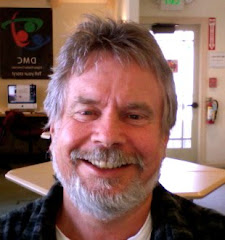Thursday, February 4, 2010
Fretting 2.0
It all began with the spring semester 2009 Curriculum Design class. I tried to start out with some perspective by putting on the Moodle links to both Barbara’s blog post (http://www.languagelabunleashed.org/2009/struggling-with-the-syllabus) and to Malcolm Gladwell’s TED talk about pasta sauce, psychophysicist Howard Moskowitz and the principle of horizontal segmentation (see September 19 post).
The intention was to set up what I am thinking of as the two central human principles of syllabus design, namely
(1) you are not doing your job properly if you do not experience at least some degree of syllabus panic shortly before the beginning of a new term or progamme;
(2) the more relevant and effective we want our syllabus to be, the more we have to help students identify their specific needs and goals and thence develop appropriate choices for them.
As Barbara unpacks the being “awash in panic” in that January post, she mentions addressing her students’ needs and describes her role as, in part, “to nudge, push, prod them towards their goals.” These relatively gentle contacts replace the tightly scheduled forced march of the traditional language syllabus (“if this is Tuesday then this must be the preterite” is Barbara’s characterization”), but she has concerns is about removing a detailed structure and replacing it with training in the use of on-line tools to explore and connect with the Spanish-speaking world (the course in question is a Spanish conversation class) followed by the challenge to create a maintain a blog in the target language . The concerns are about “scaring them off” and unnerving them by asking participants to contribute significantly in defining the class and creating a meaningful learning community.
For me (and, I suspect, for Barbara too, as the post is tagged “fear2.0”), this panic, this “plotting, fretting, and hoping” replaces the old fears that the splendidly detailed and exact syllabus one had created was relevant and feasible. That panic 1.0 was accompanied by the related anupholsteryphobia, Stanlee Brimberg’s splendid term for the fear of not covering all the material. Which means, as I recollect, that syllabus panic 1.0 never went away; to the contrary, it could actually spiral into ever-increasing nervousness as the end of the term approached. Fretting 2.0, in contrast, is gradually relieved as the students become comfortable with their role, relish the flexibility and take the course in expected directions.
Consider this from Barbara’s post, a definition of designing a syllabus: the instructor should “weave [the students’] wants and desires together and craft a schedule of events that will give them the time, the space, the support they need to make their personal learning outcomes happen.” Beautifully put: it should be clear by now, I hope, why I have been carrying this post around for a year.
In other words, as the schedule is crafted (or co-crafted perhaps), the learning community is founded, the space is defined, and the journey begins, then Panic 2.0 subsides and the joy of the shared adventure takes over.
Now it is late January 2010 and I am in the same place again, still determined, in Barbara’s terms, to avoid “snorkeling through the content” and focus on “deep water scuba diving in the sharktank of learning.”
Thanks again, Barbara. We, about to panic, salute you.
Naked Teaching in the Inverted Classroom
In terms of students becoming versed in new material, Bowen makes the case for podcasts, talking powerpoints (or audiotours), “serious” games, peer instruction and review (using e mail, Facebook, and so on, as appropriate). Some of the talking powerpoints and games he has himself created can be experienced at www.josebowen.com. These means the banishing of both direct instruction and class business, the latter taken care of through e mail, Facebook and the like; the former by students listening to podcasts, readings texts and so on, all integrated through a course management tool such as Blackboard (or Moodle).
For me, there is a very direct path from this position to much of what I have learned from Co-operative Learning – especially Jigsaw procedures. There is a vagueness in Bowen’s piece which makes me uneasy: the descriptions of the classroom are highly unspecific and have no apparent structure. This continued in the radio interviews he gave (exposure on NPR is not common for higher education practice, so attention was rightly given).
But faculty development programmes and teaching/learning centres on college campuses are there to help. The hard part, I think, is doing away with the old, burning the worn, shabby clothes of traditional pedagogy. While the emperor might be only lightly clad for the moment, he is at least aware of the need for new clothes.
And that’s the naked truth.
Mapping the Buzz
These areas are labeled “disproportionate event enclaves” because of the tendency for the more significant events (screenings, fashion shows, concerts, theater premiers, gallery openings) to happen there and for “spillover nodes” (not specified, but I assume restaurants, bars, clubs, coffee shops and the like) to be found in the vicinity. The researchers plan to extend their investigations across time (other years) and space (other cities) in order to further explore patterns of “social agglomeration.”
All of which might sound a little obvious, a little pretentious, or maybe both. But it did set me thinking again about the possible ways to localise an ESL curriculum. In a possible lociculum (locabus?) model, it would be incumbent on a needs assessment to perform the equivalent of mapping the buzz, or, because it sounds grander and more technical, tracing the disproportionate event enclaves, along with their spillover nodes. More specifically, I suspect that the responsibility of the needs assessment might be confined to sketching the outlines (perhaps the contours, or isoglosses, or isotherms?) of these enclaves because it will be the task of the learning community to fill in the details through their work together.
This corresponds nicely, I think, to the light specification of the syllabus called for in progressivist or post-structural approaches.
How would this work proceed? The data will be less extensive than the Currid-Williams-Getty archive, but more varied: local newspaper accounts, TV clips, in-person observations, interviews with key local players, on-line sources and so forth. The data base might be anchored in a large and detailed map, with coloured pins and other devices. Google Earth would be a potent complementary online tool. Products might include guidebooks, posters, journals and the like.
Come to think of it, mapping the buzz might well create its own . . . well . . . buzz.
Plants and Factories
Last Saturday’s Says You [or Sez You, maybe: I have never seen it written], featured a round of differences: tavern versus saloon, pupil versus student, repulsive versus repugnant and so forth. I noted particularly the discussion of plant and factory. It seems that while the latter refers to the building or set of buildings within which manufacturing takes place, the former term covers not just the buildings but also all the equipment and other resources inside.
This distinction is confirmed by my Longman’s Modern English Dictionary:
Plant: the assemblage of buildings, tools, etc. used to manufacture some kind of goods or power.
Factory: a building or group of buildings where goods are manufactured by collective production.
Why am I intrigued by this? Because syllabus design used to be like building a plant. We created the space, we installed the machines and tools, we ordered the raw materials. Then the students came to work.
Now syllabus design is like building a factory. We are still responsible for creating the space, I think: we name and advertise the course, locate it in classrooms both actual and digital. Everyone knows ahead of time what kind of business we are in. But now we wait for our fellow workers to arrive, and only then do we consider what machines to install, what tools to make available, what raw materials to order.
And, of course, I especially like that final phrase in the definition of factory: “collective production.” The essence of education, say I.





